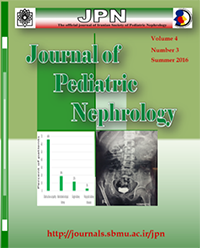Comparison of the Incidence of Postoperative Hyponatremia after Infusion of Hypotonic Versus Isotonic Intravenous Solutions in Children
Journal of Pediatric Nephrology,
Vol. 4 No. 3 (2016),
22 December 2016
,
Page 92-96
https://doi.org/10.22037/jpn.v4i3.12432
Abstract
Introduction: Hyponatremia is the most common electrolyte disorder in patients following surgical interventions (19-50%). Hospital acquired hyponatremia is often due to using hypotonic solution s and can be lethal.
Materials and Methods:Between January and December 2014, 190 children (1 month to 12 years) who were admitted in the urology department of Children’s Hospital Medical Center for elective surgical procedures were enrolled in the study. The patients were randomly divided into two groups: group I received 50 mEq/L sodium and 20 mEq/L potassium in D/W 5% and group II received 154 mEq/l sodium and 20 mEq/L potassium in D/W 5% at the maintenance dose for a period of 6 hours following the operation. The patients did not have any oral fluid intake 6 hours postoperatively. The incidence of hyponatremia before and after maintenance IV fluid therapy was analyzed. Other characteristics of the patients such as age, gender, duration of hospitalization, other concomitant electrolyte disturbances, and symptoms of hypervolemia were also evaluated. The incidence of fluid-IV therapy-induced hyponatremia was investigated and analyzed in different categories of patients.Results: One hundred and ninety patients were enrolled. The mean age was 3.75 years (ranging from 1 month to 12years). One hundred and thirty-three patients (70%) were boys. The incidence of hyponatremia before and after maintenance IV fluid therapy was 9.5% and 36%, respectively. After the therapy, the incidence of hyponatremia was 54% and 17% in hypotonic and isotonic groups, respectively. Final multivariate logistic analysis showed that hyponatremia was common in patients that received hypotonic solution after surgery.
Conclusions: Hyponatremia was markedly induced in patients receiving hypotonic solution after surgery. It seems isotonic fluid therapy after surgery protects the patients from hyponatremia.
Keywords: Hyponatremia; Isotonic solutions; Hypotonic solutions; Child.- postoperative hyponatremia
- isotonic Fluids
- hypotonic fluid
How to Cite
References
Holliday MA, Segar WE. The maintenance need for water in parenteral fluid therapy. Pediatrics. 1957;19(5):823-32.
Moritz ML, Ayus JC. Hospital-acquired hyponatremia: why are there still deaths? Pediatrics. 2004;113(5):1395-6.
Paut O., Rémond C., Lagier P., Fortier G., Camboulives J., Severe hyponatremic encephalopathy after pediatric surgery: report of seven cases and recommendations for management and prevention, ANN. FR. ANESTH. REANIM 2000;467-473.
Hoorn EJ, Geary D, Robb M, Halperin ML, Bohn D. Acute hyponatremia related to intravenous fluid administration in hospitalized children: an observational study. Pediatrics 2004;113(5):1279-84.
NAJAFI-N and VEYCKEMANS.F On behalf of the Belgian Association for Paediatric Anaesthesia: J. BERGHMANS, F. DE GROOTE, A. DE VILL, J. HUYS, J. LAUWERYNS, B. LOVENIERS , N. NAJAFI , T. PIROTTE, E. ROOFTHOOFT , L. VEECKMAN ,T. VERHAEGHEN, P.M. VERMEULEN , K. VERMEYLEN and F. VEYCKEMANS, Belgian recommendations on perioperative maintenance fluid management of surgical pediatric population, (Acta Anaesth. Belg. 2012, 63, 000-000
Neville K, Verge C, O’Meara M, Walker J. High antidiuretic hormone levels and hyponatremia in children with gastroenteritis. Pediatrics. 2005;116(6):1401–1407
Singh S, Bohn D, Carlotti AP, Cusimano M, Rutka JT, Halperin ML. Cerebral salt wasting: truths, fallacies, theories, and challenges. Crit Care Med. 2002;30(11): 2575–2579
Bailey A. G., McNaull P. P., Jooste E., Tuchman J. B., Perioperative crystalloid and colloid fluid management in children: where are we and how did we get here?, ANESTH. ANALG., 110, 375-390, 2010.
Karen Choong, MB,a,b Steve Arora, MD,a Ji Cheng, MSc,b Forough Farrokhyar, PhD,b,c Desigen Reddy, MD,d Lehana Thabane, PhD,b and J. Mark Walton, MDa,c Hypotonic Versus Isotonic Maintenance Fluids After Surgery for Children: A Randomized Controlled Trial, PEDIATRICS Volume 128, Number 5, November 2011
Sarah McNab, MBBS, Trevor Duke, MD, Mike South, MD, Franz E Babl, MD, Katherine J Lee, PhD, Sarah J Arnup, M Biostat, Simon Young, MBBS, Hannah Turner, BSc, Andrew Davidson, MD140 mmol/L of sodium versus 77 mmol/L of sodium in maintenance intravenous fluid therapy for children in hospital (PIMS): a randomized controlled double-blind trial, The Lancet, volume 385,No 9974,2015.
STANDARDS FOR PAEDIATRIC IV FLUIDS: NSW HEALTH PURPOSE, http://www.health.nsw.gov.au/policies/ August 2015.
- Abstract Viewed: 422 times
- PDF Downloaded: 227 times

